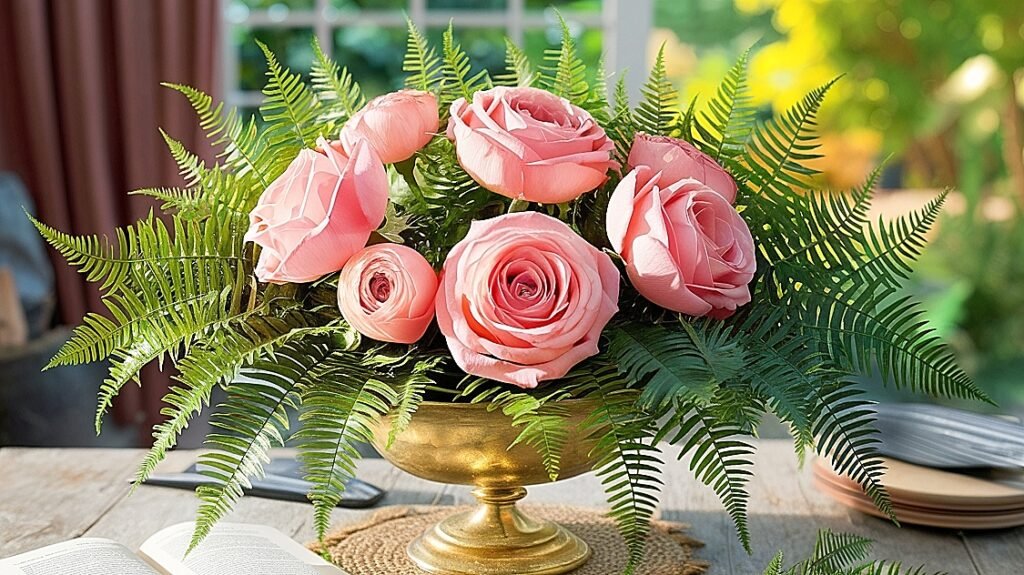
This website contains affiliate links, and some products are gifted by the brand to test. As an Amazon Associate, I earn from qualified purchases. Some of the content on this website was researched and created with the assistance of AI technology.
Key Takeaways:
- Balance roses with complementary greenery for visual interest and texture
- Mix different types of foliage for varied shapes, colors and textures
- Eucalyptus adds elegance and a fresh, relaxing fragrance
- For rustic looks, use vining greens, herbs and garden-gathered branches
- Succulents provide architectural structure and lasting freshness
- Vary greenery according to season for the most natural, cohesive look
As a lifelong rose aficionado and floral designer, I’ve come to truly appreciate the importance of selecting just the right greenery accompaniments. Too often, I see lush, romantic rose blooms diminished by an afterthought assortment of plain, predictable leaves and stems. But when paired with thoughtfully chosen botanicals that harmonize their colors, textures and movement, those very same roses take on a whole new “wow” factor. Done well, greenery not only complements but elevates every rosy nuance and detail.
Greenery Pairing Guide for Rose Arrangements
| Greenery Type | Rose Color Pairing | Occasion |
|---|---|---|
| Eucalyptus | White, Blush, Red | Weddings, Formal Events |
| Ferns | Coral, Peach | Whimsical Themes |
| Ivy | Lavender, Yellow | Rustic Settings |
How to Create a Balanced Arrangement with Greenery and Roses?
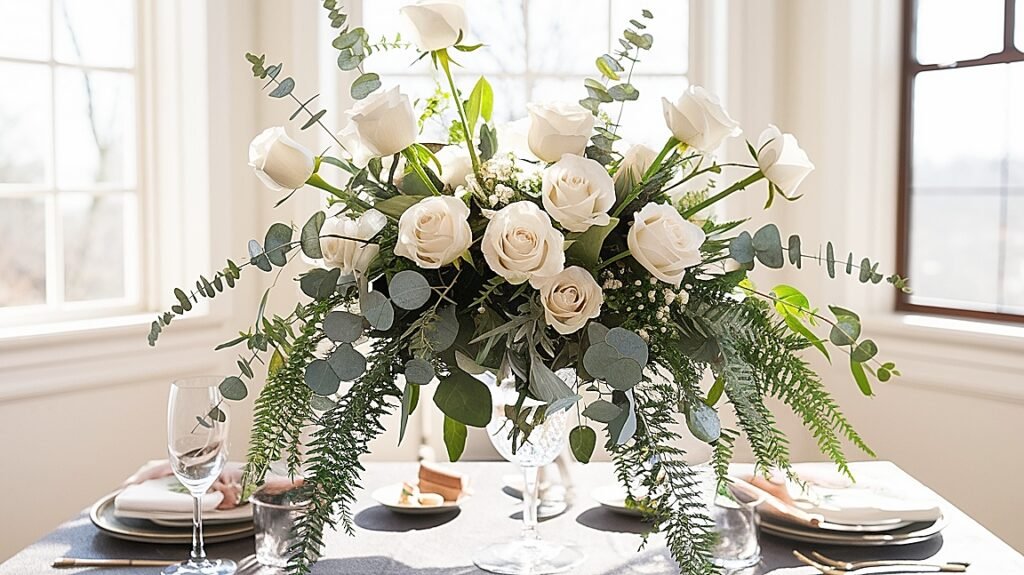
Much like adding the perfect accessories can make or break an outfit, surrounding roses with well-chosen greenery accents is essential for achieving that ideal “finished” flourish. Too little foliage and the roses can look stark and incomplete. Too much smothers their beauty. The goal is to frame, accent and balance the roses in an aesthetically-pleasing way through contrasting and complementary botanical textures.
Create this harmonious look by selecting one or two greenery varieties as your primary, plentiful accent foliage. Their ample presence will provide a lush backdrop and foundation for the roses to shine against. Then incorporate smaller pops of more delicate, airier greens throughout the arrangement as airy accents. Bringing in a few trailing vines or branches helps soften any harsh lines or gaps as well.
Achieving just the right interplay between bold and whispy, weighty and delicate foliage lends that effortless, organic elegance rose arrangements are prized for. With the right ratios and editing eye, the natural beauty of both roses and botanicals can be singularly radiant. You’ll find even more pro greenery styling tips in the full post – keep reading!
What Are the Best Types of Greenery to Pair with Roses?
- Italian Ruscus – With its broad, leathery evergreen leaves and sturdy, branching lengths, Italian ruscus lends lush volume and sturdy structure to any arrangement.
- Seeded Eucalyptus – In shades from blue-green to silver, eucalyptus varieties like Baby Blue add rich tones, distinctive fragrance and polished, trailing beauty.
- Dusty Miller – The soft, fuzzy silver foliage provides the perfect textural contrast to velvety rose blooms while its blue-grey undertones are utterly unique.
- Israeli Ruskus – Sporting a similar linear shape to Italian ruscus but with dark, glossy leaves, Israeli ruskus offers sculptural elegance with visual depth.
- Plume Celosia – Feathery plumes in shades of orange, green and burgundy arc dramatically amidst roses, infusing wildly whimsical movement.
- Parvifolia Eucalyptus – Prized for its dainty rounded leaf shape and cinnamon red stems, Parvifolia Eucalyptus has a soft, billowy quality perfect for airier bouquets.
- Leucadendron – Like something from a Dr. Seuss book, this South African novelty foliage commands attention with its wildly protruding stems and cone-like shapes.
How Does Eucalyptus Enhance the Elegance of Roses?
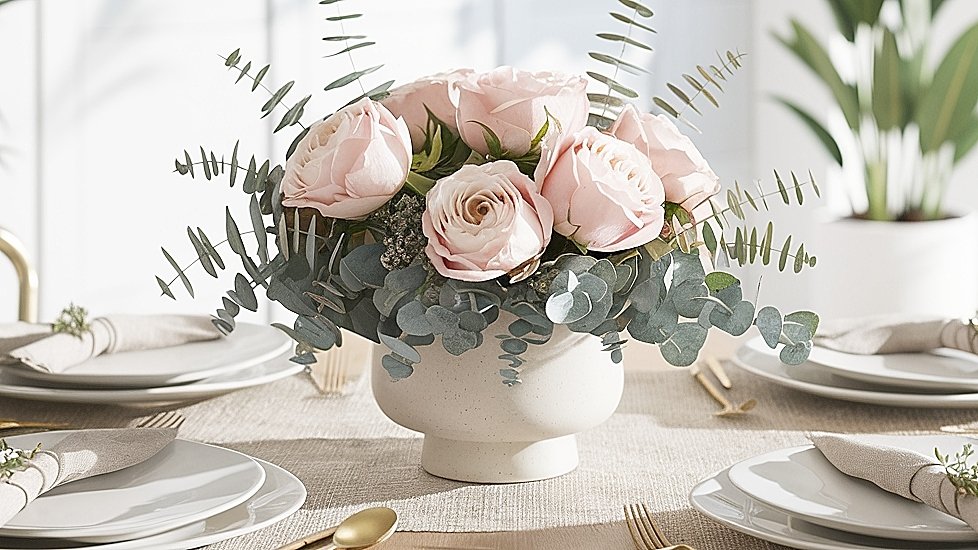
In my book, you just can’t beat eucalyptus varieties when it comes to elevating rose arrangements to luxuriously elegant new heights. With its distinctive silver-green and blue foliage tones, velvety textures and pleasantly aromatic fragrance, eucalyptus instantly lends a spa-worthy dose of zen relaxation to any floral design.
I adore how the rounded, trailing shapes of silver dollar eucalyptus add such rich, effortless movement alongside the more structured lines of rose stems and blooms. Seeded eucalyptus like baby blue brings swirls of cool, soothing colorways into the mix. While gunni eucalyptus captivates with its pearly, jewel-toned oblong leaves and angled stems.
Using generous sweeps of differing eucalyptus varieties creates that signature “garden-grown” quality so coveted in rose arrangements these days. Even as a simple, monochromatic greenery base for highlighting roses, their graceful lines, organic flow, and aromatherapy notes are pure effortless decadence. looking for more summer rose decor ideas? Check out one of my latest articles about Choosing the Perfect Roses for Summer Patio Decor.
What Greenery Works Best for a Rustic Rose Arrangement?
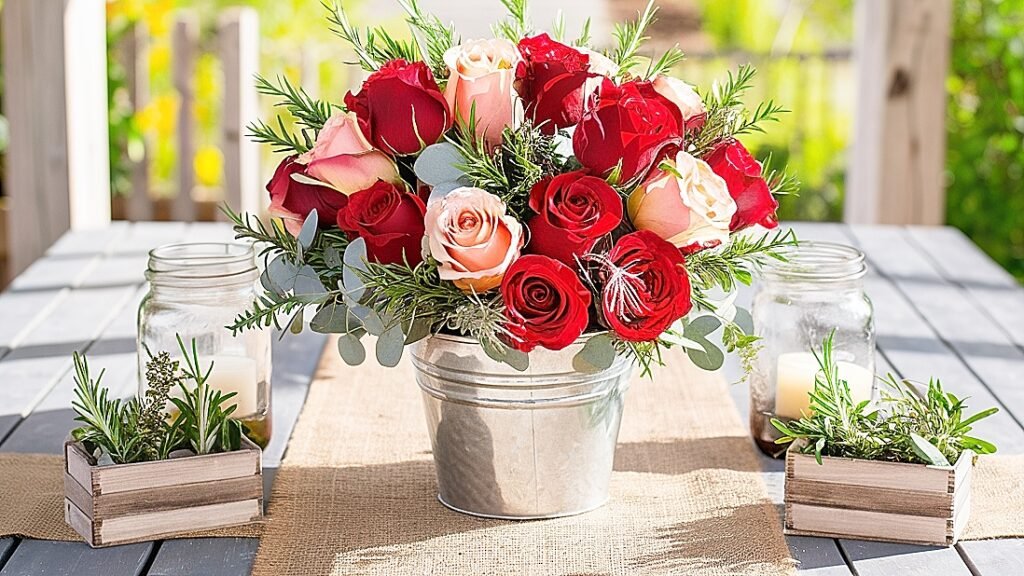
- Curly Willow Branches – Grown from the bark of willow trees, these twisty, gnarled vines seemingly reach and grab for roses with natural sculptural beauty.
- Queen Anne’s Lace – Its delicate, domed white flowerets and fine stem texture add charming, meadow-inspired airiness around heavier rose blooms.
- Scented Geranium Leaves – Nothing enhances a rustic cottage garden look like the distinctively shaped and fragrant foliage of scented geraniums.
- Olive Branches – With their gnarled, silvery-green leaves and stems, olive branches contribute an unmistakable Mediterranean earthiness.
- Autumn Foliage – Preserve fall’s glory by tucking in colorful leaves, bittersweet and other seasonal botanicals for organic, ephemeral artistry.
For arrangements with a rustic-chic or “Garden Plucked” aesthetic, the key is choosing greens with looser, more wildly naturalistic shapes, textures and colors. Think vining greens, herbs, fruits and foraged branches that look like they were literally snipped straight from the backyard veggie patch or farmer’s field.
Rather than aiming for perfect uniformity, embrace character! Tattered edges, pops of color, winding shapes and interesting little blooms only amplify the rustic charm. Be generous with layering lots of textures and “imperfections.” They’re what lend that signature farmhouse-inspired warmth. Get all the inspo for your rustic arrangements right here!
What Is the Best Way to Combine Succulents with Roses?
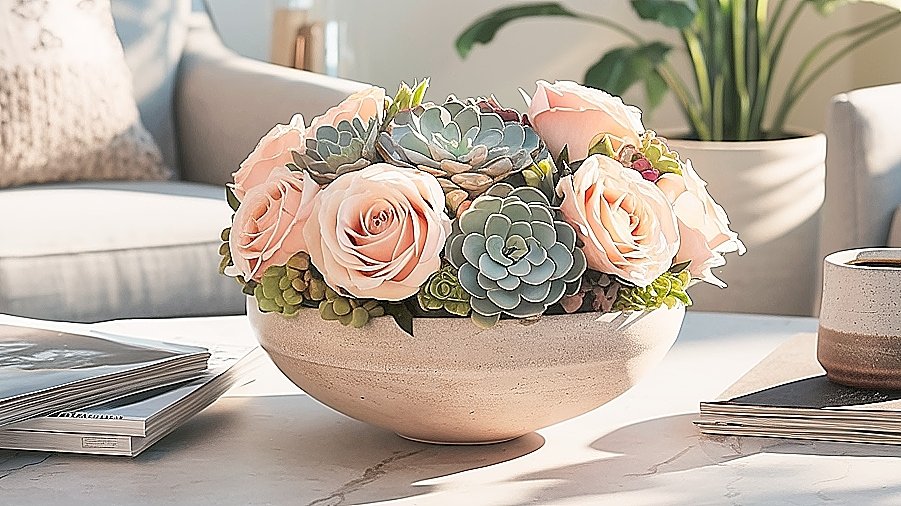
- Succulent Bouquet Accent – Tuck a few small succulent rosettes like echeveria amidst rose blooms and eucalyptus for dynamic architectural contrast.
- Rose Bowl Garnish – Circle the interior rim of a rose bowl with trailing succulent varieties like string of pearls for a lush yet low-profile frame.
- Centerpiece Base – Create a base of moss-covered floral foam, then insert tall rose stems and punctuate densely with upright succulent varieties.
Succulents contribute such a fresh perspective to rose arrangements thanks to their highly distinctive structural forms, symmetrical shapes and wildly varied textures. From rose-shaped echeveria rosettes to trailing, bean-like stems and spiky aeonium varieties, their quirky personalities add artistic geometry and negative space amidst lush rose blooms.
At the same time, succulents’ water-storing properties also offer practical benefits by prolonging arrangements’ freshness and reducing maintenance. So while they make compelling artistic statements, they deliver effortless longevity too. It’s a total win-win I explore in much more detail throughout this post!
How to Choose Greenery for Seasonal Rose Arrangements?

Achieving a sense of seasonal authenticity and cohesiveness within your rose arrangements all comes down to your choice of complementary greenery. Nothing looks more out-of-place than a summery tropical green paired with fall-blooming roses. So let the particular time of year be your guide when composing each botanical masterpiece.
For spring designs, stick to lightweight greens like decorative pussy willow branches, Italian ruscus and airy plumes like bunny tails and angelica that capture April’s emerging freshness. Come summer, trail in lush vines like clematis alongside blueberry branches and garden-fresh herbs for romance and abundance.
With autumn’s arrival, revel in richer, earthier botanicals like viburnum berries, oakleaf hydrangea, crabapple branches and ornamental grasses plumes. And in winter, evergreen magnolia foliage, silver dollar eucalyptus and pinecones give a luxe yet cozy feel reflective of the season.
Beyond literal botanicals associated with different times of year, pay attention to corresponding color palettes as well. Spring and summer arrangements shine with brighter, more vivid greens. Fall and winter call for deeper olive, burgundy and metallic accents. Follow these seasonal shifts in tone just as much as plant variety for a truly holistic flourish.
How to Style a Rose and Greenery Arrangement for a Rustic Wedding?
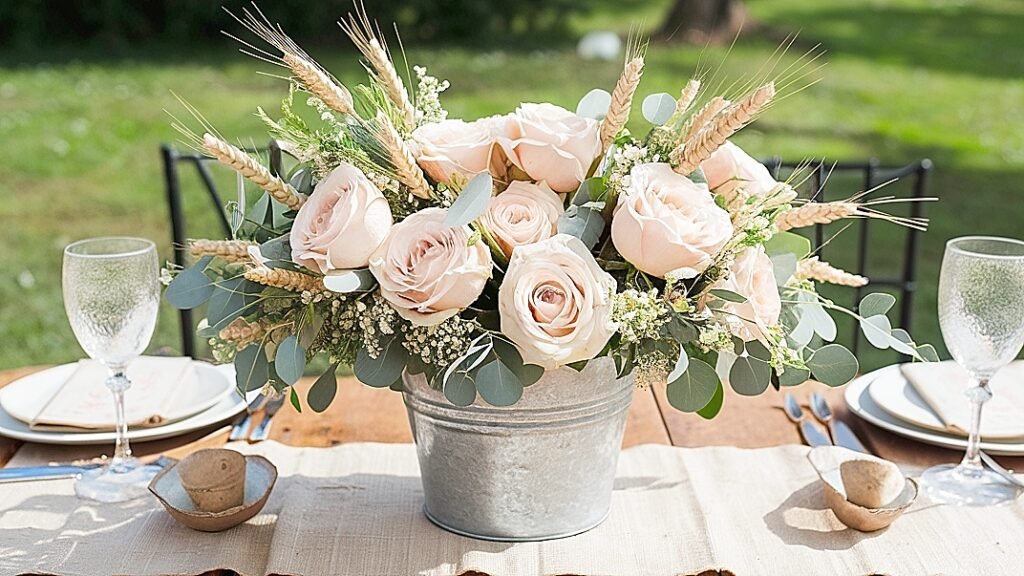
While many modern weddings lean into sleek, ultra-curated design styles, the rustic bride often prefers an elegantly undone, “fresh from the garden” look for her floral decor. And you know what? Rose arrangements provide the perfect canvas for achieving this charming rustic vibe when paired with lush yet carefree botanicals.
To establish a lovely “just-picked” quality from the start, fill your vessel with masses of locally-grown greens like olive branches, pieris, plum tree foliage and trailing clematis vines. Let some stems arc naturally over the sides and puddle loosely. This organic draping lays the botanical “bed” for your roses to nestle within.
Next, punctuate those mounds of greenery with creamy garden rose blooms, pops of airy Queen Anne’s lace, lavender wands and even cheerful daisies. The more you vary the shapes, sizes and textures, the more effortlessly abundant and just-gathered-from-the-field it feels. Finally, accent a rose and greenery arrangement for that perfect pop of rustic color by tucking in blackberries, bittersweet vines or bright viburnum berries.
The goal is to compose a garden-inspired masterpiece where the roses look like the star blossoms plucked from a wildflower meadow, not a hothouse. By blending untamed greens with generous, asymmetrical shaping, your rose focal point will brim with freeform, rustic-chic romance! Check out more of my expert tips for nailing the rustic weddings vibe.
Conclusion
From providing a lush backdrop to introducing unique textures and movement, strategically incorporating greenery can elevate any rose arrangement into a botanical work of art. But beyond mere aesthetics, the right greens also infuse essential colors, fragrance and organic style that harmonize the overall design.
As a floral designer, the key is always looking for innovative, complementary greenery varieties that bring out rose’s very best qualities – not detract or overpower them. An eye for texture, shape, color and form is crucial for striking that pitch-perfect balance.
So be bold and experiment! Mix sleek eucalyptus with fuzzy dusty miller. Pair feathery plume celosia with garden-snipped herbs like rosemary. And never underestimate the high-end luxury vibe magnolia imparts amidst delicate garden roses. The possibilities are limited only by your creativity!
This website contains affiliate links, and some products are gifted by the brand to test. As an Amazon Associate, I earn from qualified purchases. Some of the content on this website was researched and created with the assistance of AI technology.
